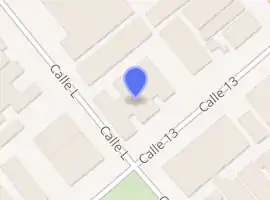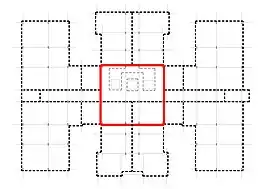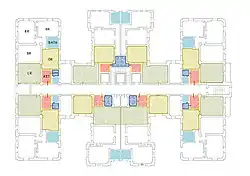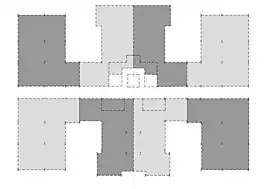López Serrano Building
The López Serrano Building was the tallest residential building in Cuba until the construction of the FOCSA in 1956.[2] It was designed by the architect Ricardo Mira in 1929 who in 1941 would also design La Moderna Poesia bookstore on Obispo Street for the same owner. It is often compared to the Bacardi Building in Old Havana, built two years before the López Serrano Building, because of their similarity in massing and central tower. The congressman, senator and presidential candidate Eduardo Chibás was living on the fourteenth floor penthouse when he committed suicide in August 1951 on the air at CMQ Radio Station.[2]
| López Serrano Building | |
|---|---|
 As seen from the FOCSA Building corridor. | |

| |
| General information | |
| Type | Residential |
| Architectural style | Art deco |
| Location | Vedado |
| Address | 108 Calle 13 & L |
| Town or city | |
| Country | |
| Coordinates | |
| Construction started | 1929 |
| Completed | 1932 |
| Owner | Jose Antonio Lopez Serrano |
| Height | |
| Architectural | 57.4 metres (188 ft) |
| Tip | 65.61 metres (215.3 ft) |
| Roof | Terracota tiles |
| Technical details | |
| Structural system | Steel frame |
| Material | Brick, terracotta tile walls |
| Floor count | 10 + 4 tower |
| Floor area | 92,000 square feet (8,500 m2) |
| Lifts/elevators | 3 |
| Design and construction | |
| Architect | Ricardo Mira |
| Structural engineer | Miguel Rosich |
| Other designers | Enrique García Cabrera |
| Main contractor | Watch and Rosich |
| Known for | 1st Cuba skyscraper[1] |
| Other information | |
| Number of rooms | 78 apts[2] |
History
.jpg.webp)
The construction of the building was promoted by José Antonio López Serrano, a publisher who ran La Moderna Poesía. He was the son of Ana Luísa Serrano and José López Rodríguez, "Pote", a banker with ties to publishing.[3]
Pote arrived in Cuba as a poor and illiterate teenager who became an influential banker with ties to the government. In 1890 Pote married Ana Luísa Serrano, a wealthy widow who owned one of the best bookstores in Havana, La Moderna Poesía. After the marriage, Pote took charge of the business opening several branches in other locations in Cuba. José López's fortune was due not only to his advantageous marriage to Ana Luísa but also from supporting the Cuban independence cause. Relations with the main Cuban leaders would bring important economic benefits. Among these political alliances was the figure of General José Miguel Gómez, whom Pote financed the 1907 electoral campaign that would propel Gómez to the Presidency of the Republic. In 1908 Pote got an exclusive contract to print the tickets of the National Lottery, which translated into extensive financial benefits. He monopolized the printing of official documents such as bonds, stocks, stamps and bank notes, printed in La Casa del Timbre.[1] Later, he would obtain from the Government of Gómez the concession for the construction of an iron bridge over the Almendares River connecting Calle Calzada with Miramar.[4] José López Rodríguez committed suicide on March 28, 1921, at the time, he had accumulated 93 million dollars.[5]
A36 steel

The López Serrano Building has a U.S. standard structural steel frame system. A36 steel, is a type of structural steel used as a system of construction that is commonly bolted or riveted. As the technology for riveting steel members was absent in Cuba, the frame of the López Serrano Building was welded in place and the reason for the high level of stiffness of the structure.[6] As with most steels, A36 has a density of 7,800 kg/m3 (0.28 lb/cu in). Young's modulus for A36 steel is 200 GPa (29,000,000 psi).[7] A36 steel has a Poisson's ratio of 0.26, and a shear modulus of 75 GPa (10,900,000 psi).[8]
A36 steel in plates, bars, and shapes with a thickness of less than 8 in (203 mm) has a minimum yield strength of 36,000 psi (250 MPa) and ultimate tensile strength of 58,000–80,000 psi (400–550 MPa). Plates thicker than 8 in have a 32,000 psi (220 MPa) yield strength and the same ultimate tensile strength of 58,000–80,000 psi (400–550 MPa).Wikipedia contributors, "A36 steel," Wikipedia, The Free Encyclopedia, [9] The electrical resistance of A36 is 0.142 μΩm at 20 °C. A36 bars and shapes maintain their ultimate strength up to 650 °F (343 °C). Afterward, the minimum strength drops off from 58,000 psi (400 MPa): 54,000 psi (370 MPa) at 700 °F (371 °C); 45,000 psi (310 MPa) at 750 °F (399 °C); 37,000 psi (260 MPa) at 800 °F (427 °C).[10]
Methods of joining
A36 is readily welded by all welding processes. As a result, the most common welding methods for A36 are the cheapest and easiest: shielded metal arc welding (SMAW, or stick welding), gas metal arc welding (GMAW, or MIG welding), and oxyacetylene welding. A36 steel is also commonly bolted and riveted in structural applications.
Tower

Above the ten stories in the main body of the building, centrally located, is a tower of four apartments supported by ten steel columns that protrude from the main mass. The ten-story block is subdivided into four aisles to allow for a stair, three elevators and a brick wall down the middle which further subdivides the block into two apartments. The two apartment blocks to the east and west, have a line of structural columns running down the middle which in turn subdivide the apartment. An interior public corridor runs perpendicular to the three blocks, parallel to Calle 13, and links to the stair and three elevators. There is secondary stairs near the east entrance with windows at every landing. There were no fire stairs required by the Havana building code. The four luxury tower apartments were occupied by José Antonio López Serrano who lived on the top floor, it was later occupied by Eduardo Chibás.
Walls
The exterior walls are brick with one inch, integral color cement plaster finish. There are raised plaster ornaments on the exterior walls and inscribed lines in the plaster suggesting a masonry bond in the lower part of the wall. There are also terracotta design panels inserted over some of the openings. All the windows and doors of the building are wood and glass in a wood frame. The floor of the apartments are covered with tiles with red and green geometric designs, there are tile baseboards. The interior walls are terracotta tile and covered in cement plaster. The floor of the lobby, the porch, and entrances to the building have ornate designs in red and black or red and green terrazzo. The walls of the lobby are Moroccan, book matched, red marble panels.[11] There is a nickel-silver relief El Tiempo (‘Time’) by graphic designer Enrique García Cabrera on the elevator wall of the lobby.[1] The elevator doors are pivot hinged and originally were nickel silver with various Art Deco designs.
Distribution


As per Havana zoning laws, the ground floor was required to have a porch facing 13th Street. It also had to provide public, commercial establishments. To this end, the building had various stores, a barbershop, restaurants and coffee shops. The distribution of the upper floors is as follows: from the second to the tenth floor, the building has eight apartments per floor, six with a separate service entrance opening directly into the kitchen and service area. Each apartment has access from the kitchen to what is called in Havana a "patio" (dark blue), this is an area equipped with a sink for doing laundry.[12] A similar room labeled a patio can also be found in other modernist buildings such as the FOCSA Building of 1956 and the apartments at the Edificio del Seguro Médico of 1958 on La Rampa. The four apartments in the center have two bedrooms each. The east and west apartments have three bedrooms each and an extra small maid's bedroom located next to the kitchen with a toilet and a shower. Each apartment has a small bathroom with a window close to the bedrooms. The main entrance door to the apartment opens directly into the living room. Only the apartments in the center block have a short corridor connecting the bedrooms. This shortage of corridors in the design mandates that the circulation occurs mostly through the rooms thus decreasing their effective square footage. The dining room is connected to the kitchen and the patio. The center apartments on the south side have a smaller entry vestibule. Every apartment was originally provided with modern amenities: hot and cold water, gas, radio, and telephone service.[2] The López Serrano Building was the country's first co-operative apartment corporation.[13]
References
- "López Serrano, el Edificio que recuerda a un gran empresario". Retrieved 2018-09-19.
- "Edificio López Serrano (Spanish)". Retrieved 2018-09-16.
- "Paseos por La Habana (Spanish}". Retrieved 2018-09-17.
- "JOSÉ LÓPEZ RODRÍGUEZ 'POTE'". Retrieved 2018-09-21.
- "José López Rodríguez (Pote)". Retrieved 2018-09-20.
- "Grade Guide: A36 Steel". Retrieved 2018-09-19.
- "MatWeb A36 steel bar". MatWeb. Retrieved 21 January 2012.
- Wikipedia contributors, "A36 steel," Wikipedia, The Free Encyclopedia, https://en.wikipedia.org/w/index.php?title=A36_steel&oldid=926289735 (accessed February 6, 2020).
- https://en.wikipedia.org/w/index.php?title=A36_steel&oldid=926289735 (accessed February 6, 2020).
- Wikipedia contributors, "A36 steel," Wikipedia, The Free Encyclopedia, https://en.wikipedia.org/w/index.php?title=A36_steel&oldid=926289735 (accessed February 6, 2020).
- "EL PRIMER RASCACIELOS DE CUBA". Retrieved 2018-09-15.
- Fernandez, Eduardo. "Guía de Arquitectura de La Habana". juntadeandalucia.es. Retrieved 22 September 2018.
- "Preservation of Community Assets". Retrieved 2018-09-23.
Gallery
.jpg.webp)
.jpg.webp)
.jpg.webp)
 Stairs behind elevator to basement.
Stairs behind elevator to basement..jpg.webp)
 Calle 13
Calle 13 Calle 13
Calle 13.jpg.webp)
_cropped.jpg.webp)
External links
- DEconstruccion
- Edificio López Serrano
- Lopez Serrano Building Architecture, Havana . Cuba
- The Lopez Serrano Building in Vedado district of Havana, Cuba.
| Wikimedia Commons has media related to Edificio López Serrano. |
| Wikimedia Commons has media related to Buildings in Havana. |